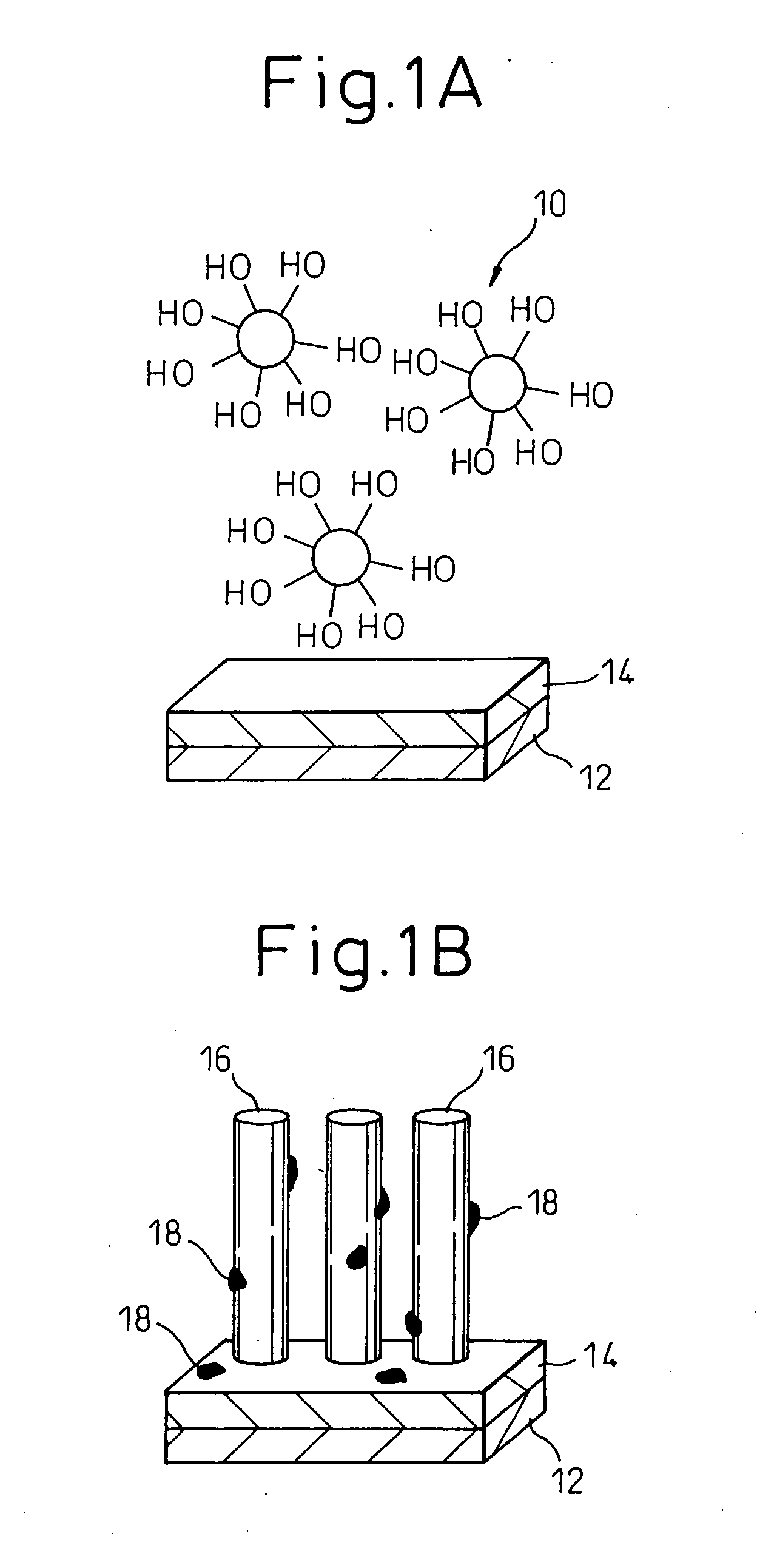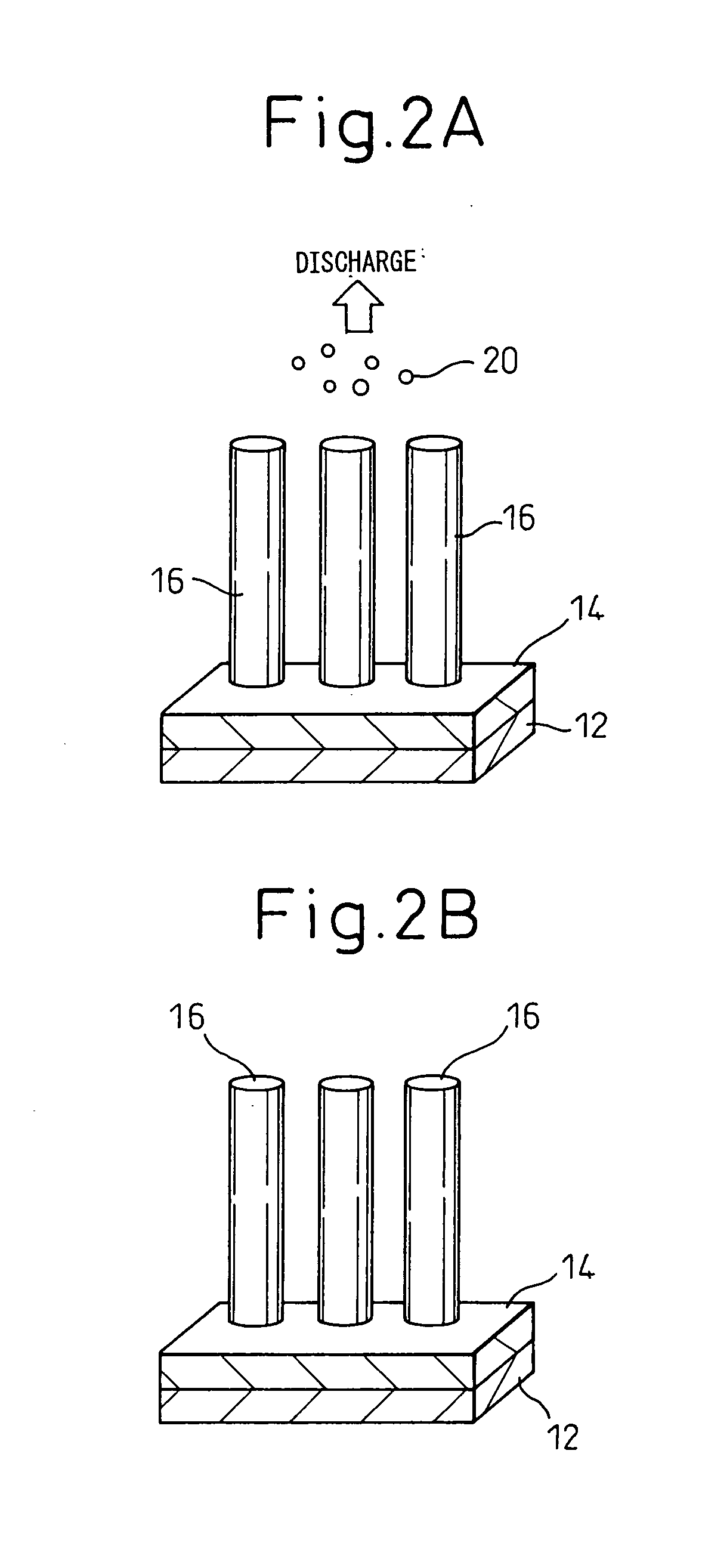Method of manufacturing carbon nanotubes
a manufacturing method and carbon nanotube technology, applied in the direction of carbonsing rags, chemistry apparatus and processes, fulllerenes, etc., can solve the problems of difficult to isolate them completely, and not applicable to carbon nanotubes manufactured directly on the substra
- Summary
- Abstract
- Description
- Claims
- Application Information
AI Technical Summary
Benefits of technology
Problems solved by technology
Method used
Image
Examples
example 1
[0043] C60 fullerene chemically modified with OH groups (C60(OH)12) is used as a compound for the carbon source having functional groups. C60(OH)12 is sublimated (or it may be dispersed in a solvent and then be vaporized by boiling the solution). As shown in FIG. 1A, sublimated C60(OH)12 fullerene 10 is introduced into a thermal CVD chamber (not shown) in which a silicon substrate 12 having a catalyst layer 14 formed on the surface thereof by evaporation of Ni is disposed. By heating the interior of the chamber to 600° C. at 1 kPa, C60 (OH)12 is reacted with Ni catalyst to produce nickel carbide. Then, more C60(OH)12 is supplied to thereby grow carbon nanotubes 16 as shown in FIG. 1B (for the sake of simplicity, C60(OH)12 fullerene is not shown in FIG. 1B). The carbon impurities 18 such as amorphous carbon which deposit during this process have higher reactivity as compared to the nanotubes 16, so that they react with OH group chemically modifying C60(OH)12 to produce volatile compo...
example 2
[0044] Iron porphyrin containing an Fe atom in the center of a porphine ring comprising benzene rings is used to grow carbon nanotubes by a thermal CVD method. The iron porphyrin is introduced into a chamber in which a silicon substrate (a silicon substrate having an oxide film naturally formed on its surface may be used) has been placed, and the interior of the chamber is heated to 500° C. at 1 kPa to thereby decompose the iron porphyrin and to grow carbon nanotubes on the substrate using Fe as a catalyst. The carbon impurities which deposit during this process are removed by the effect of hydrogen contained in the iron porphyrin, and clean carbon nanotubes are obtained.
example 3
[0045] Benzene sulfonic acid monohydrate, C6H5SO3H.H2O, is used to grow carbon nanotubes by a thermal CVD method. Benzene sulfonic acid monohydrate is introduced into a chamber in which a silicon substrate having evaporated Ni thereon (a silicon substrate having evaporated Ni on the naturally formed oxide film on the surface may be used) has been placed, and the interior of the chamber is heated to 700° C. at 700 Pa to decompose the benzene sulfonic acid monohydrate and to grow carbon nanotubes on the substrate using Ni as a catalyst. The carbon impurities which deposit during this process are removed by SO3H of the benzene sulfonic acid, and clean carbon nanotubes are obtained.
PUM
| Property | Measurement | Unit |
|---|---|---|
| diameter | aaaaa | aaaaa |
| purity | aaaaa | aaaaa |
| diameter | aaaaa | aaaaa |
Abstract
Description
Claims
Application Information
 Login to View More
Login to View More - R&D
- Intellectual Property
- Life Sciences
- Materials
- Tech Scout
- Unparalleled Data Quality
- Higher Quality Content
- 60% Fewer Hallucinations
Browse by: Latest US Patents, China's latest patents, Technical Efficacy Thesaurus, Application Domain, Technology Topic, Popular Technical Reports.
© 2025 PatSnap. All rights reserved.Legal|Privacy policy|Modern Slavery Act Transparency Statement|Sitemap|About US| Contact US: help@patsnap.com


